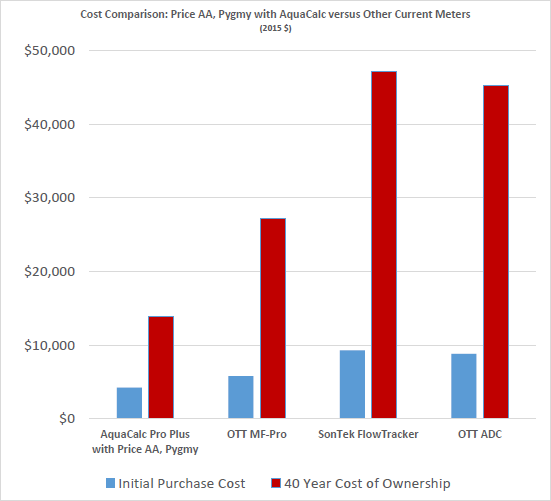 Loading... Please wait...
Loading... Please wait...Hydrological Equipment
NEWS RELEASE
Cost and Accuracy Comparisons

Mechanical Current Meter System with AquaCalc Versus Other Point Velocity Discharge Systems
Download PDF
- Home
- Stage Measurement
- Flumes
- H-Flume
- HS Flume, Fiberglass
The Dust Bowl experienced by the United States during 1930’s saw the establishment of the Soil Conservation Service (SCS) on April 27, 1935. The SCS was established as a permanent agency the US Department of Agriculture with a mission to conserve the nation’s soil and water resources.
With this mandate, researchers at the SCS began the investigation and development of a class of flumes suitable for use in measuring agricultural flows. The H Flume, so called because it was the eighth in a series of flumes investigated, combined the flow sensitivity of a narrow angle V-notch weir with the flat floor and self-cleaning properties of a flume.
The H series of flumes are more modified weirs than they are true flumes – with a V-shaped throat and no diverging / discharge section. The H flume design allows a wider range of flows than any other flume type – providing low flow sensitivity as well as the ability to measure high flow rates. Applications such as edge-of-field runoff monitoring that have low average flows and substantially higher rain even flows are idea candidates for H flumes.
The flat floor of the H flumes means that it passes sediments and smaller debris fairly easily. However, smaller HS / H flumes are generally not recommended for use on flows containing sanitary solids or larger debris as these can lodge in the narrow discharge of the flume.
H Flume Materials
- Aluminum
- Fiberglass (FRP)
- Galvanized steel
- Stainless steel
Aluminum H flumes are commonly used for remote applications where the flume must be lightweight and rugged but where cost is not as the driving decision factor. Fiberglass is used to measure edge-of-field and industrial discharges. Galvanized steel is a lower cost material used when measuring surface water runoffs. Finally, stainless steel is used when material durability and resistance to corrosion and abrasion are paramount.
Accessories
- Standard and custom approach sections
- Piping / end connections
- Flow condition options
- Flow meter mounts
- Sampler / parameter mounts
Applications
- Edge-of-Field Monitoring
- Watershed Monitoring
- Dam Seepage
- Industrial Discharge Monitoring
- Sewage Treatment Plants (screened / treated flows)
- Spring Discharge Measurement
H flumes Classes
- HS: low flows: (0.00016 to 0.803 cfs)
- H: medium flows: (0.004 to 84.0 cfs)
- HL: high flows: (0.005 to 116 cfs)
For a given height (D = flume depth):
- HS flumes are the narrowest (1.05D) and average length (1.5 D)
- H flumes average in width (1.90 D) and short length (1.35 D)
- HL flumes the widest (3.20 D) and average length (1.5 D)
The v-shaped discharge of the H flume means that is has little resistance to downstream submergence. As a result, H flumes have very small submergence ratios (HS / H 25%, HL 30%) and should always be designed for free-spilling discharge. Should an H flume become submerged, a complex equation must be used to correct the indicated flow rate.
One drawback of the H flume design is its relatively short length – with the primary point of measurement (Ha) close to the inlet of the flume. For applications where the flow approaching a H flume needs additional conditioning before it reaches the flume or where the flume is being adapted to measure piped flow, long, rectangular approach sections have been developed.
Approach sections are usually 3 to 5 times the maximum anticipated head (Hmax) in length. As a default, Hmax is usually assumed to be the flume’s depth.
For example: a 1.0-foot H flume would have an approach 3 to 5-feet long (3-5D).
Note that when using H flumes with approach sections on flow streams is a high solids content (or larger solids), sedimentation may occur in the approach section. Here, sloped floors have been used to direct the flow to one side of the flume, with minimal change in flow accuracy.
Also, unlike the flume itself, strict dimensional accuracy in construction the approach section is not required so long as the flow is fully directed into the flume.
809-080-01 HS-Flume Fiberglass


